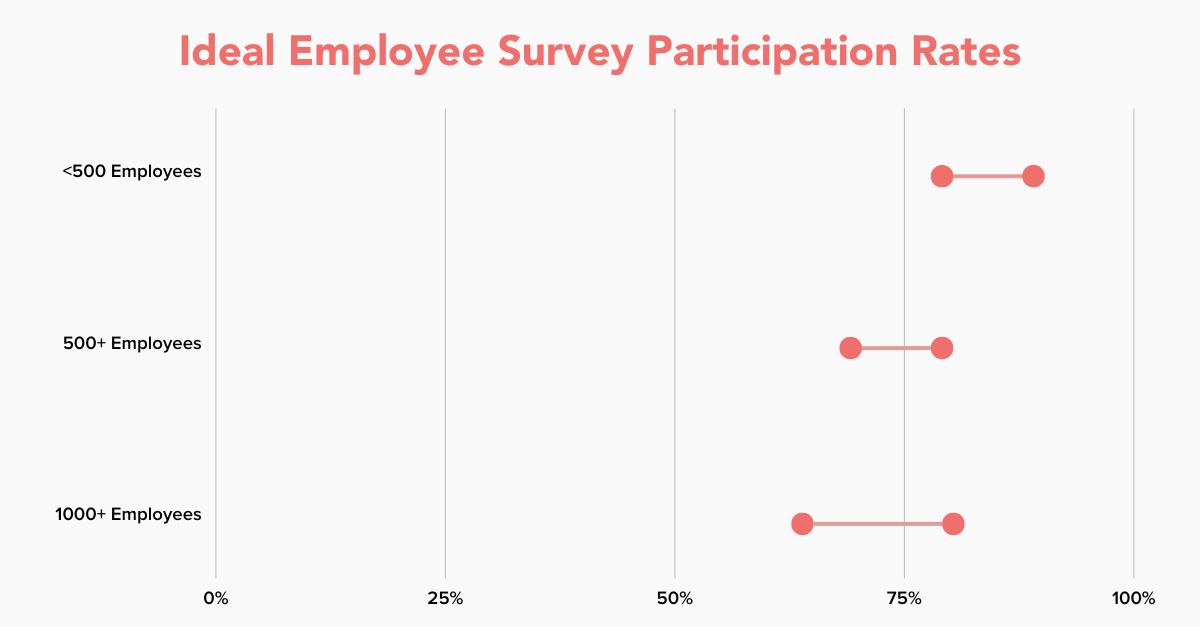Employee surveys take time, effort, and money— but they can pay off in big ways for your organization. However, if your employees aren’t participating in surveys, your team’s precious resources are at risk of being squandered.
Survey participation is an essential part of the feedback process, but encouraging your employees to share their voice is often easier said than done.
In this article, we’ll cover seven ways to set your survey up for success so you can start collecting the feedback and data your organization needs to thrive.
Why employee survey participation matters
Employee survey participation is more than just a routine task; it’s a vital channel through which organizations gain valuable insights into their workforce’s sentiments, needs, and aspirations.
Through employee surveys, your company will:
- Identify issues affecting employee experience: Early detection of issues is crucial for organizational success. A culture of open communication and survey participation encourages employees to voice concerns that might otherwise go unnoticed. This proactive approach fosters an environment of transparency and trust between employees and management.
- Receive insights for improvement: Employee surveys provide an avenue for organizations to tap into the collective wisdom of their workforce. By gathering data on employee satisfaction, engagement levels, and workplace experiences, organizations can identify trends and patterns that inform decision-making.
- Empower your employees: Participation in surveys empowers employees to have a voice within the organization. Feeling heard and valued is essential for employee morale and engagement.
The significance of encouraging participation in these surveys cannot be overstated, as it directly impacts both employees and the organization as a whole.
What is a good employee survey participation rate?
One might think that the goal of encouraging employees to participate is to achieve 100% participation— but this isn’t exactly the case.
A 100% survey participation rate simply isn’t realistic, especially for mid- to large-sized organizations. In fact, if everyone participates, it may indicate over-encouragement. If employees feel too pressured to share their voice, it may lead to less-than-honest feedback.
Quality data is more important than the quantity of data.
That said, if too few people participate, there will not be enough points to make data-driven decisions, no matter how thorough the responses are.
The sweet spot depends on the size of your company.
- Less than 500 employees: 80-90%
- Between 500-1000 employees: 70-80%
- More than 1000 employees: 65%-80%

7 ways to encourage employee survey participation
Here are seven ways to encourage employees to participate in survey participation.
1. Ensure clear communication about the survey and expectations.
Clear communication is crucial for ensuring survey participation because it sets the foundation for employee engagement. When employees are well-informed about the purpose, benefits, and expectations of the survey, they are more likely to view it as a meaningful opportunity to contribute their insights.
- Notify employees well in advance about the upcoming survey.
- Explain the purpose and significance of the survey.
- Describe how their participation contributes to positive changes.
- Emphasize the short amount of time that it takes to complete the survey.
- Prepare employees for the types of questions they will encounter.
2. Guarantee anonymity and privacy.
Maintaining anonymity and privacy in surveys is paramount to fostering honest and open feedback. When employees feel assured that their responses are confidential, they are more likely to share their genuine thoughts and concerns without fear of repercussions.
- Assure employees that their responses will remain confidential.
- Emphasize that individual responses will not be traced back to them.
- Explain the security measures in place to protect survey data.
- Highlight the organization’s commitment to data privacy regulations.
3. Get leadership to buy into it.
Securing support from leadership reinforces the significance of the survey. When executives and managers endorse the survey’s importance, it underscores that employee opinions matter at all levels of the organization.
- Highlight the executive team’s commitment to acting on survey results.
- Encourage managers to actively promote the survey to their teams and leading by example.
4. Use an engaging survey design.
The design of the survey directly impacts participation. Clear and engaging survey questions facilitate smooth responses, reducing confusion and making the survey-taking process more enjoyable for employees.
- Surveys should be no more than ten questions.
- Practice filling out the survey. It should take no more than ten minutes.
- Craft questions in a straightforward and easily understandable manner.
- Avoid jargon and complex language that might confuse participants.
- Include a variety of question formats like open-ended and rating scales.
- Ensure that question flow makes sense in the order presented to participants.
5. Choose the right time and make it convenient.
Selecting the right time for the survey launch and ensuring its accessibility via mobile devices are essential factors in encouraging participation. Convenience enhances the likelihood that employees will take the survey seriously and allocate time for completion.
- Launch the survey during periods of manageable workloads.
- Avoid times of high stress or busy project phases.
- Avoid sending too many surveys in a short period.
- Optimize the survey platform for mobile devices.
- Allow employees to participate from anywhere, at their convenience.
6. Send gentle reminders— but don’t pester.
Sending timely reminders is an effective way to boost survey participation, but it’s crucial to strike the right balance. A reminder should serve as a nudge rather than a nag. Don’t be afraid to get creative with reminders!
Remember: Never single out an employee for a reminder or question someone whether they’ve taken it or not. This can make an employee doubt the anonymity of the survey and lead to less-than-honest responses.
- Send a friendly reminder email 48-72 hours after launching the survey
- Send a final nudge 24 hours before the survey closes
6. Show employees their feedback matters.
Demonstrating that their feedback has driven positive change encourages ongoing engagement in future surveys. Share results with your teams, as well as how that feedback will lead to changes or new initiatives within the organization.
- Communicate survey findings to employees transparently.
- Highlight key takeaways and trends from the responses.
- Explain how specific employee feedback has influenced decisions.
- Showcase instances where changes have been implemented due to feedback.
7. Continuously improve your process.
Continuous improvement of the survey process is an integral aspect of fostering employee engagement and gathering valuable insights. Organizations that embrace a culture of ongoing refinement in their survey methods and procedures demonstrate a commitment to not only understanding their workforce but also acting upon their feedback effectively.
By regularly assessing the survey’s effectiveness, organizations can fine-tune questions, formats, and survey frequency to ensure they remain relevant and engaging to employees.
Additionally, feedback mechanisms for the survey itself can be established, allowing employees to suggest improvements or changes, thereby creating a collaborative approach to enhancing the survey experience.
Engage your employees in the process
Encouraging active employee participation in surveys is essential for optimizing your organization’s initiatives. By implementing the tips outlined in this article, HR leaders can maximize the utility of surveys and make the most of their organizational resources.
Your workforce possesses valuable insights that can drive meaningful improvements. Harness it!
